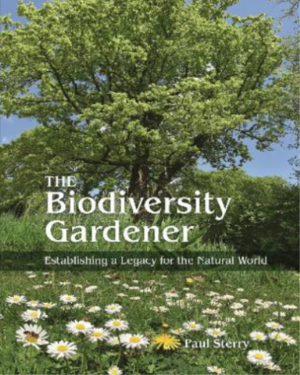BOOK REVIEW The Biodiversity Gardener: Establishing a legacy for the natural world by Paul Sterry (2023) Wild Nature Press & Princeton University Press.
First published in British Naturalist September 2023, 26-27.
 Anyone who has one of Paul Sterry’s many other books will know to expect an array of excellent photos from all corners of the natural world. The remarkable thing though is that the majority in this book have been taken in his own Hampshire garden, in the habitats he has himself helped to create, whether by design or informed ‘neglect’ over the course of the last decade.
Anyone who has one of Paul Sterry’s many other books will know to expect an array of excellent photos from all corners of the natural world. The remarkable thing though is that the majority in this book have been taken in his own Hampshire garden, in the habitats he has himself helped to create, whether by design or informed ‘neglect’ over the course of the last decade.
But this book also showcases the author’s powerful words, full of passion and polemic, albeit drifting into pessimism, sometimes laced with a gentle humour, about the state of nature around us and the perils we have inflicted upon it during our lifetimes. For someone like me who shares almost all his views on the ecological heresy of gaudy annual plantings masquerading as meadows, the glory of Ragwort, the blind (destructive) faith that ‘tree-planting is good’, the de-skilling of naturalists through reliance on dodgy apps etc, it helps validate my own world view.
What it is also is a manual for those who want to try and do this sort of wildlife gardening for themselves, and an inspiration as to what they could achieve. By ‘this sort’ I mean small-scale rewilding, or maybe ‘renaturing’: there is almost no mention of the value of (some) garden plants to our native wildlife.
So, I see this as an important book, one that anyone interested in their immediate surroundings ought to have. It should sit alongside the magisterial Wildlife of a Garden by Jenny Owen which covers similar ground (with more lists) but in the context of a more traditional suburban family garden, and the book that has probably not yet been written: the one that details, in the way these two books do, the wealth of actual creatures that have been encouraged by targeted ‘gardening with wildlife in mind’ using the multicultural array of garden plants we have available from around the world.
The book exudes quality, from its binding to the heavy, non-shiny paper and the colour reproduction, and lack of any obvious errors. The only criticism I could make (and this is maybe very personal) is that the body text looks rather archaic (the sans serif box text I find more appealing) while the juxtaposition of serif and sans serif fonts for headings and subheadings is visually jarring. But do not let that put you off buying it!
Dr Chris Gibson FBNA